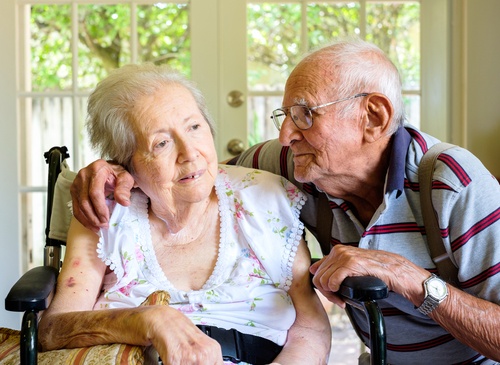In our two most recent blog posts, we covered ways in which to communicate more successfully with someone in the early and middle stages of Alzheimer’s disease and related dementias. As individuals progress to the late stage of Alzheimer’s disease, the shift from what is being said to how it is being said becomes even more significant.

Quality of life for people living with dementia is largely dependent on their connection with others. Maintaining a relationship can be a complex and challenging process, especially when verbal communication is lost. During the late stage of dementia, individuals may lose the capacity for recognizable speech, although words or phrases may occasionally be uttered.
However, even if the person can no longer communicate verbally or recognize you, they likely will still be able to communicate in other ways and feel your affection and reassurance. At this stage, non-verbal communication will become increasingly important. The world is primarily perceived through the senses by people in late stage dementia. We as caregivers can take advantage of this and use the senses to maintain a connection.
• Touch: Hold the person’s hand. Give a gentle massage to the hands, legs or feet.
• Smell: The person may enjoy the smell of a favorite perfume, flower or food, which may bring back happy memories.
• Vision: Videos can be relaxing, especially those with scenes of nature and soft, calming sounds.
• Hearing: Reading to the person can be comforting, even if they may not understand the words. Speak gently and with affection; your tone can help the person feel safe and relaxed. Music is a universal language that promotes wellbeing for most of us. Sing together or play music, especially the type of music the person has enjoyed throughout their life.
Research suggests that although someone in the late stage of Alzheimer’s has lost the ability to talk and express needs, some of the person’s core sense of self remains intact. By maintaining a meaningful connection using nonverbal communication strategies, we’re able to tap into the person’s remaining faculties and truly improve their quality of life.
This blog post is Part 3 of a 3-part series on effective communication strategies.
Amanda is a dynamic marketing professional with two decades of experience working in advertising, healthcare marketing, and corporate communications. Her experience includes market research, strategy development, program execution, event planning, and authorship of educational & promotional content. From her early days in the media department of a small advertising agency to her current role directing her organization’s marketing initiatives, Amanda has developed broad-ranging expertise in integrated marketing communications. Amanda earned her bachelor's degree in advertising from San Jose State University and spent part of her college career studying abroad at Oriel College, Oxford University, in England.